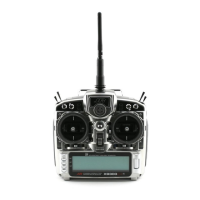FLIGHT MODES
A-6
landing speeds and again have a lot of Exponential on
the rudder to prevent over-steering upon the landing/roll
out. A couple of program mixes can be set up to bring
in some Up-Elevator to make the jet assume a positive
angle of attack, and to deploy the speed brakes. The
two mixers can then be assigned only to the 3rd Flight
Mode for landings. The Landing flap position can also be
associated with the 3rd or Landing Flight Mode and the
Gyro gain can again be turned-on to assist in a straight
roll-out during landing.
Many of the functions found in the X9303 2.4 system
are switch selectable (including programmable mixers)
and can be assigned to one or more Flight Modes. This
provides the ability to have 3 completely different aircraft
configurations that are selectable in flight using a
single switch.
Three Flight Modes are available in the X9303 2.4 system.
When Flight Modes are activated, they are selected during
flight by using one of the two 3-position switches (FLAP
Switch or AUX2 switch). The pilot decides which switch is
to be used when Flight Modes are activated in the Devic.
SEL function in the System menu. Once Flight Modes
are activated, the pilot has a choice of using the Flight
Mode switch to select up to 3 Dual Rates and Exponential
settings for each of the primary controls (ELEV, AILE,
RUDD), or Dual Rates and Exponential settings may
continue to be controlled by the 3 individual Dual Rate
switches. However, when using the standard D/R switches,
there are only 2 settings possible for each of the primary
controls because the D/R switches are only 2-position
switches. All other functions that can be activated by a
switch can be assigned to 1 or more Flight Modes when
Flight Modes have been activated.
Decide if Flight Modes are to be activated. If
3 sets of Dual Rates and Exponential settings are
desired for Elevator, Ailerons, and Rudder instead of
having only 2 sets available, then continue below to
activate Flight Modes.
If there is a desire to gang Dual Rates for Aileron, Elevator
and Rudder together on a single switch, then continue
below to activate Flight Modes.
If there is a need to group multiple functions together
in order to perform certain tasks with the aircraft, then
continue below to activate Flight Modes. If it is decided
that Flight Modes are not to be activated, then skip to
SWITCH ASSIGNMENTS below.
A Flight Mode represents an aircraft configuration (Dual
Rate/Expo, programmed mixes, Aileron Differential, Flap
System, Gyro System, etc.) that is designed and optimized
to assist the pilot and the aircraft in performing a specific
type of maneuver.
The objective of programming Flight Modes is to provide
the ability to flip a switch to select a collection of settings
that are optimized to perform a maneuver. An aerobatic
aircraft, for example, may be set up such that the Flight
Mode switch in its 1st position configures the aircraft
for normal precision flying; positioning the switch in
its 2nd position sets the aircraft up for snap rolls; and
positioning the switch in its 3rd position sets the aircraft
up for consecutive rolls, slow rolls, and rolling circles.
The 3 Flight Modes could just as easily represent aircraft
settings for Take Off, Flying, and Landing for a turbine-
powered jet aircraft. The point being that Flight Modes
can make the pilot’s job easier by configuring the aircraft
to do different things by flipping a single switch.
For example, let’s consider a jet aircraft and how Flight
Modes might be used to make the pilot’s job easier. The
jet will utilize 3 Flight Modes - 1 for takeoffs, 1 for flying
at high speed and 1 for landing.
During takeoff, full control deflections are desired, with a
moderate amount of Exponential to assist in rotation and
control of the aircraft at takeoff speed. Steering should
have a lot of Exponential to avoid over-steering during
the takeoff roll. So for the 1st Flight Mode (FM0), Dual
Rates and Exponential curves are set for Ailerons and
Elevator to allow adequate control for rotation and control
at takeoff speed, while a high percentage of Exponential
is set for the rudder/steering to help prevent over-steering
during take off. If the aircraft is equipped with 3 position
Flaps (Retracted, Take-off position and Landing position),
the Take-off flap position can be assigned to only the 1st
Flight Mode to assist in takeoff. There may also be a Gyro
attached to the steering/rudder and the Gyro gain can be
turned-on and associated with the Take-Off Flight Mode
to assist in keeping the aircraft straight during the takeoff
roll.
For normal flight at higher speeds, the 2nd Flight Mode
(FM1) would be set up to have quite a bit of Exponential
and perhaps reduced control rates on all control surfaces
because a lot less control deflection is required at
high speeds. The retracted flap position would also be
assigned to this Flight Mode and the Gyro gain could be
reduced or turned-off.
For landing, the 3rd Flight Mode (FM2) would be set
up to use full control throws with a moderate to high
degree of Exponential to smoothly control the jet at lower

